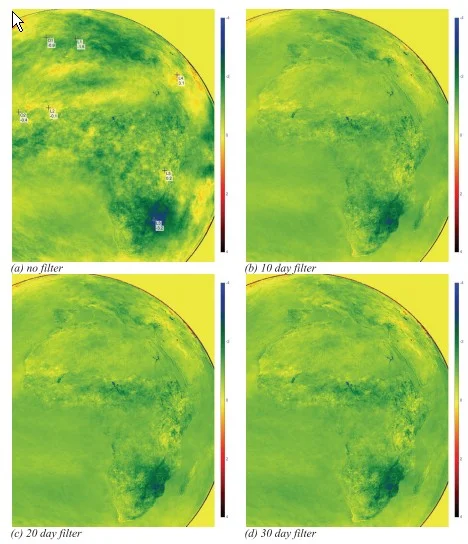These rises are held, by some, to be causing extraordinary rises in global mean temperature, as repeatedly implied for example by the IPCC's extensive use of the notorious Hockey Stick Plot in and around their 2001 AR3 report. (For details of the sloppy nature of the work that produced this plot, and of the conniving that brought it to prominence, see 'The Hockey Stick Illusion'.)
But today, let us look at two other graphics recently highlighted at WUWT that could encourage both children and adults to develop a calmer perspective on climate change, and to be more more alert to the grossly irresponsible scaremongering that can be so readily found in this area.
(1) Our first graphic is a teaser. There was an overall rise in estimated global mean temperature in the 20th century, but the rising phase in the first half was remarkably similar in size and duration to that in the second half. Cutting and pasting these phases to show them side by side on the same scale makes this quite clear, and is shown below. In one we are told that 'natural causes' can account for the rise. In the other we are told that only rising CO2 levels can explain it. The observer is invited to guess which one is which:
Source: this graphic is presented here: http://wattsupwiththat.com/2013/08/20/when-somebody-hits-you-with-that-new-ipcc-is-95-certain-talking-point-show-them-this/#more-91971 . (The C3 site also has many relevant plots, including one used in an earlier post on Climate Lessons.) (Note added 18 Sep 2013: the graphic is due to Richard Lindzen, Journal of American Physicians and Surgeons Volume 18 Number 3 Fall 2013)
(2) Our second graphic is also a teaser, but of a different kind. The observer is invited to speculate as to the intentions of those who prepared it and of those who authorised it for use on the cover of the September 2013 issue of National Geographic magazine. What were they thinking? Do they want to frighten us by any chance? Do they presume we are innumerate? Do they think that most of us will fail to check it out? Was it a grossly irresponsible action on their part to publish it? What kind of standards do they have? And so on:
Anthony Watts estimates the water height shown is about 214 feet above mean sea level. There is a sea-level measuring station nearby showing that sea level there has been rising at a pretty steady 0.0091 feet per year over the last 150 years or so:
| Source: NOAA |
He drily notes that at that rate, it will take about 23,500 years to reach the water height shown.
But what about projected rates for the oceans overall? What does the IPCC say? Their projections from the AR4 report in 2007 show between 20cm and 50cm rise in the 21stC. Let us once again do a naive projection of that into the future to see what kind of time we'd have to wait before the waters were reaching towards the waistline of the statue: 2,720 to 1,090 years if the local sea level there changed at those global rates..
The National Geographic cover is therefore nothing but an extremely wild, and extremely implausible speculation. As Watts notes at the end of his post on this:
'It is this sort of junk science sensationalism that causes me and many others not to subscribe to National Geographic anymore. '
Teachers everywhere should be on the lookout for such 'junk science sensationalism' in the teaching materials they are being asked to use on climate. Please also consider sending me details of any examples that you find if you would like them to be recorded here.
Note added 25 September 2013. Don Easterbrook has examined more assertions in the despicable article behind that despicable picture in the National Geographic. He concludes 'Summary of conclusions: From the evidence presented above, the obvious conclusion is that the National Geographic article is an absurd fairytale, completely unsupported by any real scientific data and directly contrary to a mountain of contrary evidence.' http://wattsupwiththat.com/2013/09/25/national-geographic-rising-sea-level-prophecycause-for-concern-or-absurd-fairytale/



